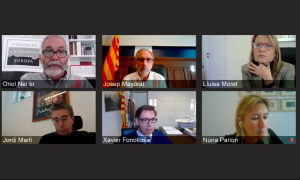"The metropolitan integration process has been accompanied by municipal segregation. What used to take place in the neighborhoods of the same municipality, now takes place in the different municipalities of the metropolitan area", stated Oriol Nel·lo, professor of geography at the University from Barcelona and member of the executive of the Catalunya Europa Foundation. Nel·lo has been in charge of leading the first session of the Municipal Conference: "Scarce municipal resources and the health and social crisis: An urgent debate", organized by the FCE with the collaboration of the Barcelona Provincial Council and the Santa Coloma Town Councils de Gramenet and Sant Boi de Llobregat, which has had the participation of Núria Parlon, mayor of Santa Coloma, Lluïsa Moret, mayor of Sant Boi, Xavier Fonollosa, mayor of Martorell, Josep Mayoral, mayor of Granollers and Jordi Martí, councilor of presidency of the Barcelona City Council.
Mayors and mayors coincide with the need to forge strategic alliances with public administrations and consistories. Lluïsa Moret, mayor of Sant Boi, highlighted the importance of coordination and trust between institutions. "Moret has also emphasized the role of local administrations in managing the social and health crisis:" the local administration manages the least resources but it is also the one that receives the most demands and the one that knows the territory best. "A statement subscribed by other speakers, such as Xavier Fonollosa, mayor of Martorell, who added that" municipalities manage services that are not within their competence but are its incumbency. "And it is that despite being the highest valued administration in the management of the health crisis, the consistories only manage 11% of total public spending.
Added to the lack of resources is the fact that the municipalities with more socioeconomic difficulties tend to have a lower rate of expenditure per inhabitant than the average because the tax base is lower. "There are no metropolitan compensation mechanisms and the differences are very notable," Oriol Nel·lo warned. Núria Parlon, mayor of Santa Coloma also bet on the need for a joint strategy to avoid a metropolitan region at different speeds.
From the Barcelona City Council, Jordi Martí claimed the need to increase the borrowing capacity of the City Councils and a reform of the local financing model, in accordance with what Pasqual Maragall had already defended, that is, a division of spending as follows form, 50% in the State, 25% to the autonomous communities and 25% to the municipalities.
However, territorial imbalances are not only manifested in the differences in spending, but also in the spending made by supra-municipal institutions. Josep Mayoral, mayor of Granollers, denounced that the Infrastructure Plan 2010-2020 concentrates 80% of the investment in the first metropolitan crown, and only 20% of the metropolitan arch. Mayoral regretted that "the concept of co-governance and co-responsibility is further away than ever." For this reason, the mayor of Granollers is committed to joint co-governance with the Generalitat, in accordance with the Barcelona Metropolitan Territorial Plan, which was approved in 2010.
At the end of the conference, Professor Oriol Nel lo concluded with three great ideas reiterated throughout the debate: The question of local financing inequalities cannot be resolved municipality by municipality, the debate on municipal resources should not be separated from debate on investment or the issue of governance.
The conference ended this morning with 3 simultaneous discussion workshops led by Toni López-Gay, Carles Donat and Helena Cruz and coordinated by Oriol Nel·lo. Throughout these workshops, it has been found that municipalities with lower incomes have a higher social expenditure per capita. This means that the richer municipalities, which, on the other hand, have more financial resources, can invest in other items such as equipment or infrastructure. In addition, the speakers also highlighted the differences in facilities between affluent areas and more disadvantaged areas, so that affluent areas have 147% more educational facilities and 71.3% more sports services (taking into account counts the sum of public and private). Markets are emerging as the most numerous facilities in disadvantaged areas. On the other hand, the associative fabric is also unevenly distributed, with 87% more tissue in affluent areas. In contrast, social innovation practices, which include free culture projects, or platforms for the right to housing, are distributed much more evenly across different neighborhoods and municipalities.








